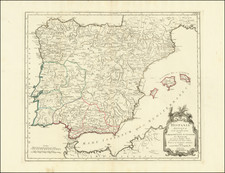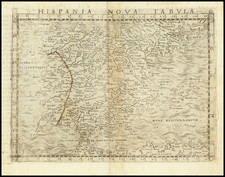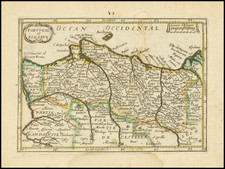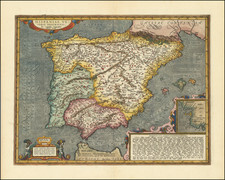This handsome and scarce bird's-eye view engraving from the Civitates Orbis Terrarum captures the essence of Lisbon, once known as Olisippo, on the banks of the Tejo (Tagus) River. This detailed work, an exquisite blend of side and bird's-eye views, offers an invaluable glimpse into the city's pre-1755 earthquake architecture, highlighting its role as a pivotal trade center connecting the Orient, various islands, Africa, and America.
This engraving serves as a historical testament to Lisbon's grandeur during a time when it, alongside Seville, was revered as a "Ruler of the oceans and the high seas." The detailed portrayal in the Civitates Orbis Terrarum illustrates Lisbon's pivotal role in maritime exploration and trade, reflecting the city's significance in global commerce and navigation. This period was marked by an era of exploration and cultural exchange, with Lisbon at the forefront as a gateway between Europe and distant lands.
The engraving is rich in detail, pinpointing landmarks such as the Castelo de São Jorge and the Catedral Se Patriarcal. The Castelo de São Jorge, identified as number 1 in the legend, is historically significant, having been a Moorish stronghold before its reconquest by Alfonso I in 1147. The Catedral Se Patriarcal, marked as number 79, stands out for its Romanesque and Gothic architecture. These features, along with the delineation of the Lower Town of Baixa and the Upper Town of Bairro Alto, offer a vivid portrayal of the city's topography and urban landscape.
The depiction of Lisbon in this engraving is especially noteworthy, considering the extensive destruction caused by the 1755 earthquake. The Civitates Orbis Terrarum thus preserved a view of Lisbon's architectural and urban splendor that was largely lost to this disaster. The post-earthquake reconstruction of the Lower Town, evident in its 18th-century style, contrasts with the historical record provided by the engraving, making it an indispensable resource for understanding the city's architectural and urban history prior to this catastrophic event.
Georg Braun (1541-1622) was born and died in Cologne. His primary vocation was as Catholic cleric; he spent thirty-seven years as canon and dean at the church St. Maria ad Gradus, in Cologne. Braun was the chief editor of the Civitates orbis terrarum, the greatest book of town views ever published. His job entailed hiring artists, acquiring source material for the maps and views, and writing the text. In this role, he was assisted by Abraham Ortelius. Braun lived into his 80s, and he was the only member of the original team to witness the publication of the sixth volume in 1617.
Frans Hogenberg (ca. 1540-ca. 1590) was a Flemish and German engraver and mapmaker who also painted. He was born in Mechelen, south of Antwerp, the son of wood engraver and etcher Nicolas Hogenberg. Together with his father, brother (Remigius), uncle, and cousins, Frans was one member of a prominent artistic family in the Netherlands.
During the 1550s, Frans worked in Antwerp with the famous mapmaker Abraham Ortelius. There, he engraved the maps for Ortelius’ groundbreaking first atlas, published in Antwerp in 1570, along with Johannes van Deotecum and Ambrosius and Ferdinand Arsenius. It is suspected he engraved the title page as well. Later, Ortelius supported Hogenberg with information for a different project, the Civitates orbis terrarium (edited by Georg Braun, engraved by Hogenberg, published in six volumes, Cologne, 1572-1617). Hogenberg engraved the majority of the work’s 546 prospects and views.
It is possible that Frans spent some time in England while fleeing from religious persecution, but he was living and working in Cologne by 1580. That is the city where he died around 1590. In addition to his maps, he is known for his historical allegories and portraits. His brother, Remigius, also went on to some fame as an engraver, and he died around the same time as his brother.









![[Portugal] Pascaarte vande Zeecusten van Portugal tusschen de Barlenges en de C. de S. Vincente geleghen, vertoonende nae't leven de ware geleghentheijt vande vermaerde Riviere van Lisbona . . .](https://storage.googleapis.com/raremaps/img/small/40065.jpg)




